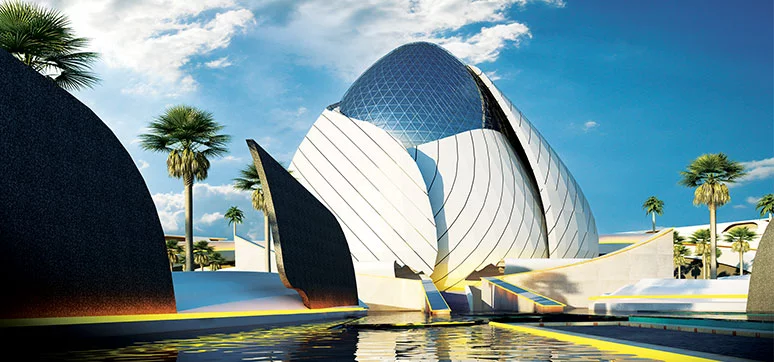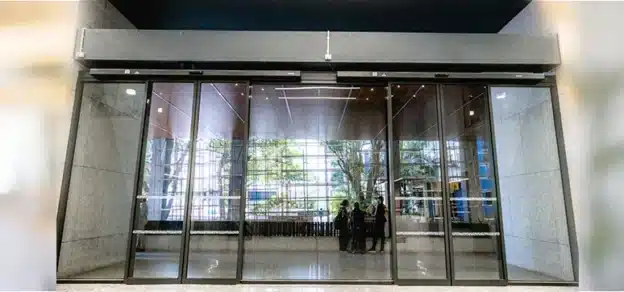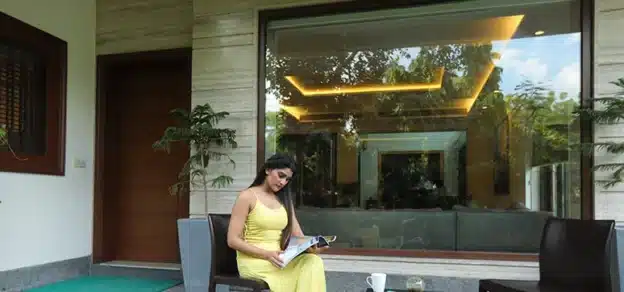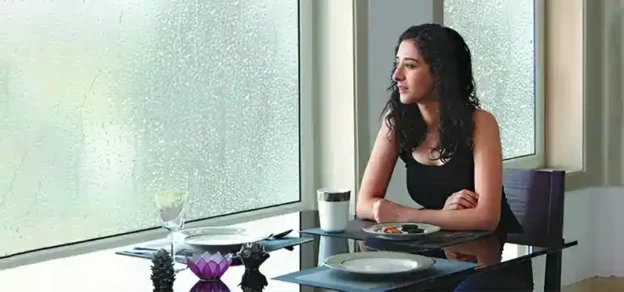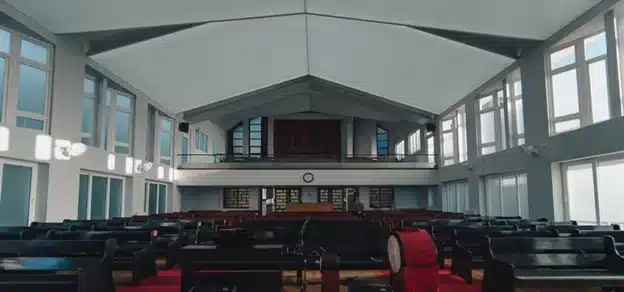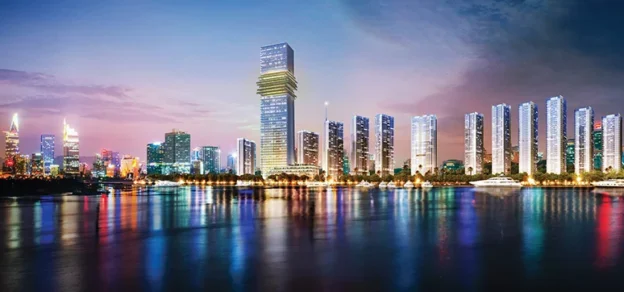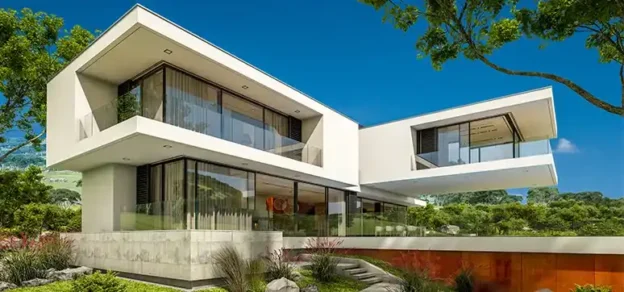The production of window glass started in 1836 in a factory in Belgium. Since then, the product has come a long way. Glass has become an inevitable part of any urban building. One of the first milestones was the invention of tempered glass in 1929 by the French glass company Saint-Gobain.
The first double glazing was produced in 1947 in Belgium, and it became popular due to its insulation capacities, both thermal and acoustic. During the 1950s, the British manufacturer, Pilkington invented a new method of glass production called float process and since then float glass has become the rage. By the end of the 20th century, 90% of the flat glass used throughout the world were float glass. Enameled and tinted glass followed this.

With the material science constantly pushing its boundaries, we saw the entry of ‘Smart Glass’, which can switch between allowing light in and blocking it out. The decorative and architectural possibilities with the use of glass are seemingly endless, while the list of extra functions that glass could fulfil has become longer – e.g., blocking UV and infrared radiation, providing thermal and acoustical insulation, and greater resistance to breaking. The cover story of this edition elucidates on versatility of glass, the need to choose the right kind of glass, management of heat ingress and light in modern glass buildings, optimising acoustic properties of glass, and much more.
Glass is an aesthetic, adaptable, versatile, economically viable and eco-friendly material which actualises possibilities in architecture and design that only few materials can. State-ofthe- art technologies for lamination and processing have made possible new types and varieties of glasses that enable the perfect blending of function and aesthetics – for both exterior and interior applications.
Glass – The Chosen Medium For Façades & Fenestrations
Glass has been quite popular in real estate because of its versatile and transparent nature. Its ample use in building walls, partitions, beams, roofs, canopies, skylights and staircases is somewhere a reflection of the transparent working atmosphere that today’s millennial generation prefers. The opennessthat glass adds to these structures makes even a mundane design interesting, points out Ar. Anshu Shukla, Deputy General Manager – Design, Kalpataru Limited.

The glass was in use as early as 7th century in buildings, and then it used to be a luxury item. With evolving technologies, today glass is more relevant than ever, especially in India, which has different environment in every part of the country, says Ar. Indrajit S. Kembhavi, Principal Architect, Kembhavi
Architecture Foundation.

“Glass enhances the visual appeal of living space and adds a touch of modernity wherever it is used,” states Vikram Khanna, COO, Consumer Glass; COO, Architectural Institutional Business; CMO, CIO, Asahi India Glass Ltd. The applications and uses of glass are as breathtaking as its effects. Glass is the material with which you can see more & do more with.
According to Khanna, it is not only light and easy to handle, but can be used in a variety of ways. Its aesthetic, self-cleaning and insulating properties, gives it a preference, depending upon where and how it is used. Glass with a plethora of products helps in reducing the weight of the building, thus resulting in less stress on the building and its foundation. Ashok Jain, Executive Director, Fuso Glass India Pvt Ltd too agrees to this.

Glass is certainly a very good material if used intelligently, points out Sharanjit Singh, Chairman, GSC Glass Ltd, agreeing with the rest. However we cannot use it based only on load calculations from an engineering standpoint and looks, or aesthetic standpoint of the client or the architect. We do need a better understanding of the building requirements and knowledge of glass and glazing.
The quantum of glass used in a design is dependent on various tangible and intangible reasons, notes Abhishek Bij, Design Plus Architects. Accounting for local weather conditions have become one of the tangible, measurable components in façade design. So it is no longer a question “if” glass is going to be used, it is a discussion on “how”, adds Bij.
Rajiv Balaggan (Sales Head- Architectural Glass India, Pilkington Glass India Pvt. Ltd.) too agrees with Bij’s statement. Glazing should be based on the purpose and use of the building, considering the weather conditions. High performance, energy saving glass products are very much advisable.

Right selection of glass is the key, adds Malvinder Singh Rooprai, Technical Consultant – Asia Pacific Region, PVB Division, Kuraray India Pvt. Ltd. Unfortunately the knowledge about the usage of the right type of glass has not matched the pace of increased usage. Structural engineers do not accept the glass as a structural material in spite of the new codes on glass released by BIS (Bureau of Indian Standards). Glass as a building material needs to be researched in our universities, the way it is in Europe, remarks Rooprai.
Glass is among a very few building construction material which luckily has an extremely low effect of weather, states Swapnil Pathak, Partner, Art- N-Glass Inc. A smart specification can actually solve a lot of issues in buildings, including excess heat, noise, energy consumption, etc.

Also it does not have a decent enough alternative, hence there are certain areas where only glass can be used. It is excellent for walkways, skylights and other load bearing installations if properly designed and executed, adds Pathak. It is a product which will keep growing in our economy as we haven’t really started using it yet, as the difference between per capita consumption of glass between India and other countries, like China, the USA, Hong Kong, etc., is huge.
Tariq Kachwala, Director – FG Glass too agrees that glass unarguably occupies the prime spot among the cladding materials, and it comes with its fair share of logical justifications. Glass façades are both pre-engineered and modular, looks great, and offer transparency.

Even in tropical climates like that of India, it remains an ideal choice for façade cladding, under certain very important considerations, adds Kachwala. The choice of glass should consider criteria such as glare, heat behaviour (both incident and reflected) and installation type. Fortunately, the range of glass tints and coatings available today, combined with advanced manufacturing and processing techniques allow for the use of highly energy-efficient glass that can replace traditional opaque walls without compromising on performance.
Varghese PV, CEO, Glazing and Metal Works, Sobha Ltd too opined that glass cannot be replaced with any other material due to its advantages and its utility is increasing with rapid technological advancement in this field. In moderate Indian weather conditions, these elements perform well. However, the risk of breakage is always there.
Contrary to the above comment, Shukla denotes that regular glass is not sustainable in Indian climate as it traps hot air indoors, thus increasing the energy to maintain the temperature. But this weakness can be tackled by handling the solar radiation in a more effective way, thus improving the performance.
Growing Demand For Glass In Low-Rise Applications

The demand for glass in the niche and low rise applications will be growing, observes Sharanjit Singh. Agreeing to this, Kachwala observes that the use of extremely large glass panels fixed in very slim aluminium systems are in demand for low-rises. This is driven by the desire to have maximum vision possible without the framing ‘clutter’. Security of the façade is of prime importance in such applications and there are glasses available today with varying levels of intrusion resistance, some even harder to break through than the steel!
Choice Of Glass For Windows For Effective Fenestration

Choice of glass for fenestration is totally dependent on the utility, intention, scale, cost, and application, says Bij. From clear to coloured, from float to laminate, using glass independently or in combination with other techniques/materials, the choice varies. There are more picks, adds Khanna, like energy efficient glass, acoustic windows based on the requirement. I.e., if the consumer laminated | frosted glass, etc., that can be put on wants to decrease heat ingress, if it is a north facing window, if there is excess solar heat coming in from the window, if the consumer wants an acoustic solution, if the window faces a noise generating area, or if he wants a privacy solution.
Agreeing with Bij and Khanna on the variety available, Shukla adds on the parameters which determine the choice of glass, such as daylight, glare, internal and external reflection and sound.
She stresses on the need for creating comfortable indoor by studying and analysing the sun-path, wind and acoustics.
Jain points on few other factors that should be considered before selecting the glass for fenestration like orientation and location of the building, safety requirements, purpose of the building (school, hospital, residence, etc.), and type of the building, viz., mall, theatre, commercial complex, etc.
“Nowadays, smart glass is used in fenestration to minimise solar gain. Screened, painted, coated and laminated glass are used depending on transitional space between the exterior and the interior which results in a beautiful combination of space, visual link, light and exterior view”, Kembhavi adds.
Complete Glass Walls – Pros And Cons

There is no limitation in having a complete glass wall even in Indian climatic conditions, says Khanna. There are varieties of glasses used externally depending on tint and thickness, and thus reducing the level of heat coming from outside. The products offer advanced solar control technology and help in ultimate cooling comfort, combined with durability and high energy efficiency applications.
State-of-the-art technologies for lamination and processing have made possible new types and varieties of glasses that enable the perfect blending of function and aesthetics – for both exterior and interior applications, Khanna explains. Few of the major trends are: improved thermal insulation glazing; façade retrofitting for better energy performance; smart glazing; integration of photo-voltaic; and innovative structural use of glass.
But some experts did not favour the glass-only façades. The greenhouse effect produced by the glazing system becomes a serious concern, observes Shukla. And a naïve use of glass in façade would only add to this concern as it would make the surroundings hotter. Bij too recommends using complete glass walls with caution. “One should take caution for orientation, choice for vision clarity, and provision of shading devices (louvers/screens/shelves). This is further enhanced by the building design/massing,” notes Bij.
Limitation in having a complete glass wall could be more in terms of affordability and access to select the correct products, states Kembhavi.
According to Singh, the main limitation of complete glass wall is to address the shading against the direct solar radiation. Combining other materials is a good idea and can give a huge arena of innovative designs while addressing energy concerns and performance strength, notes Singh, Balaggan and Kembhavi.
“I strongly believe that we have the products and the processing capabilities required to create energy-effcient façades, while on the other hand it is also important to be extremely prudent in determining the façade coverage percentage with glass,” cautions Kachwala. Instead of indiscriminate and unplanned usage as is seen in some buildings, it is important that architects and consultants jointly design architecture that is sustainable and has the minimum possible load on the heating and cooling systems, he advices.
Six Major Elements Determining the Selection of Glass:
1. Safety & security
2. Multiple load acting
3. Acoustics
4. Energy efficiency
5. Aesthetics and the most important
6. Budget
7. According to these parameters and a lot of permutation and
combination of products, we try and fit in the best possible
combination.
(Swapnil Pathak, Partner, Art-N-Glass Inc.)
The Choice Of Glass Should Be Based On:
Functional aspects & safety: A detailed study of the weather conditions, including the analysis of sun’s path is done before selecting. The building’s functional aspects are also to be considered before opting for glass. Factors such as visible light transmission is very important in the selection process. Further, the levels, angle of the façade location in terms of movement of people needs to be studied for safety.
Energy efficiency: This aspect helps decide the type and the processes. Moreover, there is a statutory requirement to comply. Ideally, look for parameters like better shading coefficient, low U-value and double glazed with 12 to 16mm space in between filled with inert gas (argon is common) for better energy saving and comfort.
Aesthetics: One is allowed to play with colours. A wide range of colours are available, which can meet all the above parameters. (Varghese PV, CEO, Glazing and Metal Works, Sobha Ltd.)

While glass façade imparts an aesthetic and contemporary look, incorrect usage of glasses will bring down energy efficiency of the building, states Varghese. In India, it is a general practise to limit the usage in façade to about 30 – 40% and use ACP, HDL, stone/ tile etc. for the remaining. This helps in making a well-balanced, energy efficient, easy to maintain, aesthetically pleasing and durable façade. Shukla says that stone cladding can act as a good heat insulating layer. Green walls with vertical gardens increases the energy efficiency and reduces the electric bills.
According to Bij, to achieve netzero, glass will always be used with other materials, as it alone cannot address all concerns. Application of it is irreplaceable, and the question arises on the intelligence of application. This is where a close communication between the manufacturing world and the design fraternity is critical. Achieving clarity and yet addressing heat percolation, cutting glare yet ensuring vision, are important, observes the architect.
Guidelines Determining the Use of Glass In Buildings
- High-performance coatings offering exceptional spectral selectivity should be adopted.
- All nuances of the façade that are responsible for heatingress should be considered during the selection process.
- Glare problems should be mitigated with the use of the various shading devices available today.
- Adequate ventilation should be provided at regular intervals for air circulation and to facilitate emergency smoke and people evacuation.
The design should conform to the building’s overall fire prevention strategy and the directives issued by the local fire-authorities should be implemented.
The final decision rests on the good judgement of building planners and consultants to create a façade that performs well on all fronts: energy, safety, cost, maintainability and life. (Tariq Kachwala, Director – FG Glass)
Energy-Efficient Glass For Green Buildings
With the dream of ‘Nearly-Zero Energy’ fast turning into a reality, green buildings are actually becoming a norm globally, through extensive use of innovative glass in buildings which helps in reducing the air-conditioning load and the need for artificial lighting, and thus minimising energy consumption in the building, says Khanna of AIS. Balaggan and Jain too agrees that excellent energy saving and high performance products are available for use today, which are suitable for local conditions.
With new types of glazing solutions, spaces – both internal and external – are becoming more efficient. The additional costs incurred in making green buildings are more than compensated by the reduced operational costs, compared to conventional buildings. With an increase in awareness about the carbon footprint, it is expected that buildings with energy efficient glasses help in reducing energy load of a building, hence incorporating energy efficient glass solutions will drive the market for construction glasses, notes Khanna.
Glass generates minimal environmental impact, which makes it a product of choice for sustainable buildings. For instance, explains Balaggan, the total CO2 equivalent emitted by the manufacturing of an energy efficient double glazing unit is offset on average within only 3 to 10 months by the energy savings realised compared to the same building equipped with inefficient glazing.
High-performance solar control glasses are best suited for a tropical country like India, states Kembhavi. Not only it is recyclable, it is also a good insulator, which combined with solar and smart air-conditioning helps buildings become self-sustainable with heating and cooling.
State-of-the-art glazing technologies when used can create a carbon negative building envelope. Dynamic glazing such as electro-chromatic and photochromatic glass offer great potential savings in locations and at orientations that experience variation in peak air temperatures and incident solar radiation from low sun angles, explains Shukla. Properly executed day lighting strategies can also reduce HVAC peak loads with corresponding reductions in mechanical equipment capacity and carbon footprint.
Singh advices to select glasses with low light transmittance and higher shading. “But the designers insist on higher light transmission as they generally perceive the transparency and Visible Light Transmission (VLT) to be the same property of a glass. We need to have external shading by any external means or we have no choice but to use a Double Glazing Unit (DGU) having its outer glass of good shading co-efficient, he elucidates. We can also look at harnessing solar energy from roofs and façades,” Singh suggests.
Pathak points out that every building/direction/geography/ height has different challenges. SHGC, U-value, VLT, width of air/ argon gap are among a few parameters which decide the type of glass and specification. Hence on the same need the product is also chosen – for example – for a building which faces a lot of sun, fins or ceramic fritt or a perforated aluminium skin would be excellent. So would be a glass with high VLT.
“According to the latest technology used around world, we believe that we should have triple low-E and double low-E combinations of the glass, with an overall thickness of 24 to 30mm for best results in energy efficiency. Further, argon gas filling should be carried out in the airspace in DGU. This will result in a product that will be able to resist heat ingress due to conduction and modest due to radiation. To tackle the problem in the best possible way, these with suitable shading elements can be provided,” enlightens Varghese.
Guidelines for Managing Solar Heat Gain
The four main aspects affecting solar heat gain are: thermal transmittance of the glass (U-value), solar heat gain through glass (SHGC), thermal transmittance of frame and air tightness of the glass assembly. The sun’s position in the sky changes seasonally and affects availability of daylight. Position of the sun is the true altitude and azimuth based on geographic location. It becomes bright when the sun angle is higher. Best orientation of buildings can be determined with the sun’s angle. The movement of sun from east to west and the angle of the sun may affect the amount of daylight penetration in a building.
(Vikram Khanna, COO, Consumer Glass; COO, Architectural Institutional Business; CMO, CIO, Asahi India Glass Ltd.)

Shukla says that we are far away from having an energy efficient glass suitable to the Indian conditions. Apart from the conventional double glazed high performance glazing systems, there have been recent developments in glass industry such as the ability to make façade glass thinner which could help reduce the logistic and operation costs and hence help in reducing the CO2 footprint. But to what extent these and other such technologies can be implemented still needs to be explored.
Management Of Natural Light & Solar Heat Gain
Balanced or smart façade will have enough light levels (300 – 500lux). This will be effective in resisting the solar heat gain, spots Varghese. We need to address this contradiction carefully to enjoy both the conditions. New generation of glasses are smart glasses that provide 35 to 50% light transmission and are capable of resisting the total heat gain effectively.
Total solar heat gain depends on several factors like U-value and shading coefficient of glass, and horizontal and vertical shading elements on the façade, explains Varghese. Out of these, first factor purely depends on the coatings and processes on the glass. However, the second and the third factors can be achieved by suitably playing with orientation of the building and shading elements. In fact, to enable the interior of the building receive natural daylight, we can use a technology called light shelf like an internal chajja placed horizontally at 8 feet height with very glossy reflecting surface on top, points out Varghese.
Reflective glass, also known as solar control glass, reduces heat gain and glare from the exterior and allows optimum VLT to the interior. It facilitates energy savings through reduction in interior solar heat gain and HVAC, and air-conditioning costs, explains Khanna.
Buildings that employ passive solar heating or daylighting often depend on well-designed sun control and shading devices. Reflective materials on glass or low SC glass combined with light shelves, adjustable louvers or blinds with overhangs or vertical fins can address light and heat management of a building, observes Kembhavi.
Heat travels into the building primarily by two causes, explains Singh. (1) Temperature difference between exteriors and interiors called thermal transfer which is easily addressed by using DGU and Low-E glasses. (2) Direct solar radiation which has to be addressed by shading. DGU and Low-E glasses do not address this transfer and do just the opposite and work as a heat trap unless we use any external shading means or use external glass of DGU for shading. We need to start with evaluating the daylighting needs first and then make a right balance of light and heat.
Acoustic Performance Of Glass
The thicker the glass, better the sound insulation. Insulated glass with an inert gas acting as sound barrier between the glasses enhances acoustic properties. Laminated glass consisting of two or more layers of glass held together with PVB layer apart from making it safer also helps in acoustical insulation since the layer help in protecting from ultraviolet rays, thus enhancing the building energy efficiency, says Shukla. Khanna too recommends PVB interlayered laminated glasses and insulated glasses which can provide 50–60% sound reduction. These glasses work well for buildings abutting the highways/railways, for hospitals and childcare centres.
Façade Elements Aiding in Reducing Solar Heat Gain
There has been a growing tendency from the architects and developers to put forward façade elements such as double glazing, vertical screens and horizontal louvers into the façade aesthetics. Well-designed double skin façades can provide both improved indoor climate and reduced use of energy. Ventilated screen, an extra skin is added to the outside of the building envelope provides additional thermal insulation. During solar irradiation, when placed as per the sunpath, it gets naturally ventilated as the heated air in the cavity rises thus reducing the solar heat gain.
(Anshu Shukla, Deputy General Manager – Design, Kalpataru Limited)
Techniques Enhancing the Acoustic Insulation of Glass
- More thickness of outside and inside glass (6 to 8mm even to 10mm as per requirement).
- Providing more space in DGU (16 to 20mm)
- Use laminated glass
- Use acoustic PVB
- Use PVB laminated glass even for both.
The above five factors will enhance the acoustic insulation value. We have to strike a balance between the requirement and cost, the cost increases with the number of steps.
(Varghese PV, CEO, Glazing and Metal Works, Sobha Ltd)
The progression for acoustic should be first to increase the thickness of the glass than to jump to DGU principals. Also, in the case of DGU, one should remember to create a differential in thickness, says Bij. Depending on the methodology of glass (thickness/DGU/lamination) the decrease in dB can be attained. A general understanding that insulating glass (IGU or DGU) also insulates against sound is a hugely false perception, Singh points out.
Agreeing with Singh, Rooprai too observes that a laminated glass fares better than an IGU unless the IGU is having a large air gap of 20 mm or more. “Using an IGU is a good solution for reducing the indirect solar heat gain (U-values) but not for acoustics, at least with the prevalent standard air gap of 12mm. Having air gaps more than 12mm is a big deterrent as it leads to increased overall framing system cost. Infact, it is better to use a single monolithic glass than an IGU,” suggests Rooprai.
Glass is generally 90% of any glazing, hence it plays a pivotal role when it comes to acoustic insulation, and there are a lot of myths and notions which needs to be addressed, points out Pathak. For example expectations in terms of decibel reduction, we can’t have a zero dB sound. Using the word sound proof is wrong. Sometimes there are multiple areas from where the noise can seep in or come but all the focus is given to glass hence making it extremely difficult to address the situation. When installing in a system, the gasket, the fabrication of the product, the installation and civil itself – all of them play important roles. Glass manufacturing companies have done an excellent job in promoting and educating about high performance glass for thermal insulation, it is time for processors to do a similar working on acoustics.
In modern façade, the initiatives taken to bring energy efficiency are enhancing its overall acoustic insulation, states Varghese. “As a thumb rule, we may look for a 40 decibel sound level inside, with a possible noise level of 70-80 decibel outside. Ideally, we aim for decibel reduction of 32dB to 44dB according to the nature of the space. High decibel reduction is desirable for the high-end hotels where the level of noise outside due to proximity to highway, railway station and flight path is high,” explains Varghese.
Awareness Levels Of Consumers
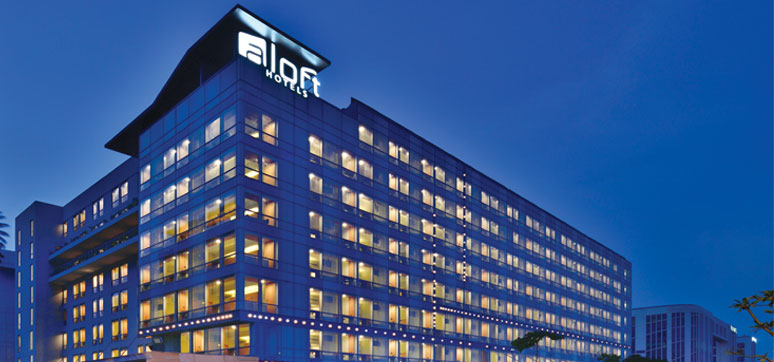
The glass industry is growing at about 8-10% a year. Government regulations such as GST and RERA have affected the construction sector, which have pushed real estate developers, architects and designers to explore more options in ‘green building materials’, this being one of them, says Khanna.
At a consumer level, says Kembhavi, the awareness is Aloft Hotel, Delhi improving drastically compared to right mind-set. Exhibitions and seminars on glass have helped a lot to spread out the awareness. The manufacturers have also initiated many awareness programs on glass, its performance and different use of glass.
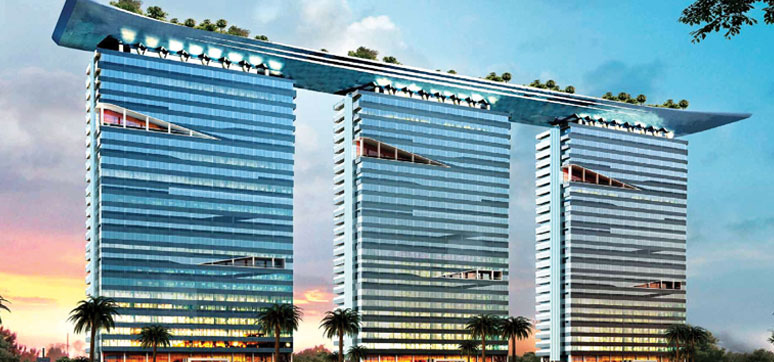
On Market Agility And Expertise To Meet The Increasing Demands
The market does have the agility and expertise but exercised by a few, opine Singh and Pathak. This can further improve if there is good coordination and understanding in the entire chain of stakeholders from the concept or planning stage of the building.
According to Bij, Indian construction industry works at 1/5th to 1/7th of cost compared to Middle East / Europe / US or other organised markets, where the protocols are also more stringent. “There is a catch 22. The problem is that while the clients are not willing to pay for the specialised expertise, there is an expectation of stringent delivery. Since, the delivery is non-exacting, an aura of negativity gets created,” spots Bij.
Go for Indian Façade Systems
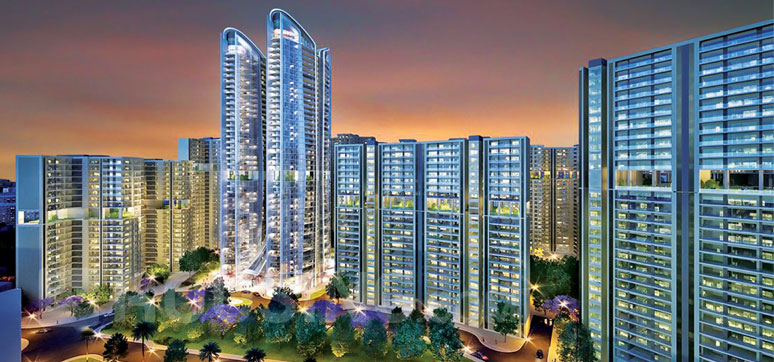
There is an unnecessary brand cost attached to the international systems which can be used by the client to get better specification and product rather than spending on an ordinary system. I think we can develop and design systems better than international system when it comes to design for our country.
Brain drain has been a problem for façade and fenestration industry as it was extremely small and not organised hence a lot of talented designers and consultants joined the bigger companies abroad but now with the new generation coming up in both architecture and fabrication the thirst for knowledge and product is more than ever. I am quite excited and sure in the coming times Indian systems will stand up and compete with the global leaders not in India but everywhere around the globe.
With the new people coming back to India after a very niche education in façade it about time that we will see similar courses in our educational institutes and exciting competition among Indian systems which will be healthy for all round development for Indian façade industry.
(Swapnil Pathak, Partner, Art-N-Glass Inc)
“Given a good R&D team, and better understanding of customer requirements, we are able to manufacture and supply to the market products that are customised to everyone’s needs. We have developed about 25 products in last 6 months as per the market requirement,” remarks Khanna, speaking about his company.
The market has grown at a very fast pace and so has the capability of the glass processors, says Rooprai. There are so many new entrants in the market making the competition very tough. Some of the old players are investing a lot to upgrade themselves or distinguish themselves from other, and to meet the specialised requirements of market in India and outside.
The use of glass in buildings has increased manifolds in the country. However in most developments, the specifications of the façade installation and system norms are far from being met, complaints Shukla. Recognising the gravity of the problem and uncertainty faced by the engineers, architects and users, the guidelines for selection of appropriate glass structures suitable for a particular location have been developed by the Bureau of Energy Efficiency (BEE). With the recurring incidents of fire breakout in buildings, fire department across most regions have become stringent in their NOCs, which to a large extent has assured safety in such buildings. Internationally, countries have laid down stringent safety laws, regulations and standards pertaining to façade maintenance but, in India we are lacking in the safety regulations!
Smart Fenestration – Solutions For The Future
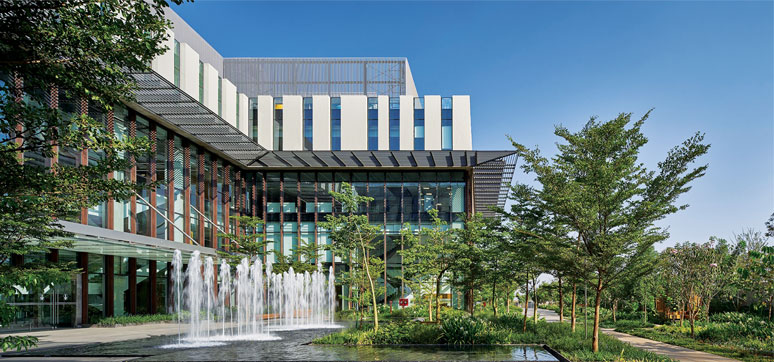
With the ever-growing demand for improved aesthetics glass safety and strength, the market is naturally seeing a lot of innovations. Consumers are testing the limit by making large glass panels. The combination of new technologies and hybrid components including hot and cold-bent glass , advanced laminating and adhesive technologies has led to an enormous increase in the efficiency of applications ,observe shukla, A sense of responsiblity towards creating a sustainable and carbon neutral building has created path for echo-friendly technologies such as glass with built-in photovaltic solar collectors , bio creative facade (algae facade) which when exposed to sunlight such that the by products , biomass and biogas are used to prodcuce electricity. Recently ,silk screen technology, digital printing and film laminates have enabled the realisation of designs which was considered impossible for a long time, remarks Shukla.
According to Singh, education and awareness is the key. “We need to train the trainers, introduce it as subject in engineering and architecture institutes as curriculum. The industry has initiated action in this direction and now the institutes have started implementing it. The architects should encourage young newcomers to learn and assist the seniors in technical aspects, material science and research while encourage seniors to have a serious look at NBC 2016 and the new addition of Glass and Glazing (section-8) under Structural Design (part-6),”denotes singh.
Smart Fenestration Solutions
Use of BIPV SIGU (Building Integrated Photovoltaic ; Sealed Insulated Glass Units) with blinds :
• Movable shading devices/ louvers
• Self-Cleaning Glass
• LED laminated Glass
• LED Display Glass
(Vikram Khanna, COO, Consumer Glass; COO, Architectural Institutional Business; CMO, CIO, Asahi India Glass Ltd.)
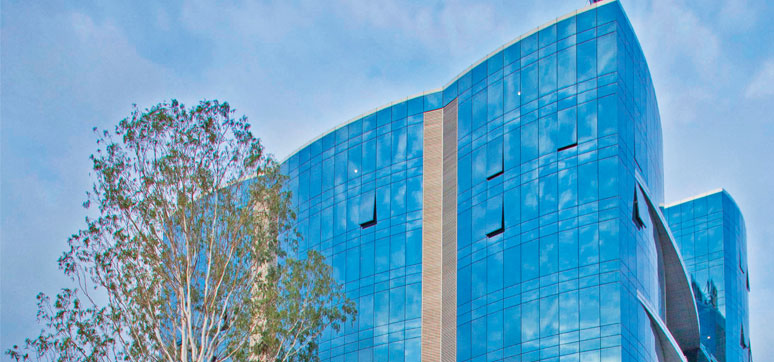
“The competition between the manufacturers has become exciting every year as we see a new better spec glass coming out and client and architect are being hands on using it. The next step is integrating a lot of electronics and nano tech which is still a long shot but with the price correction it would become feasible. The growth and the speed at which we as Indians are moving with glass is quite up to date and future looks awesome,” Pathak is optimistic. As is Varghese, and he is hopeful that smart façade will evolve going forward, with focus on providing shade on demand.
